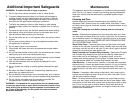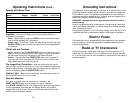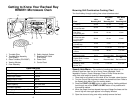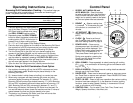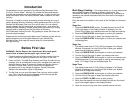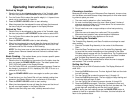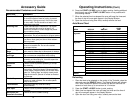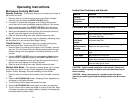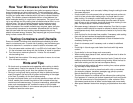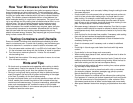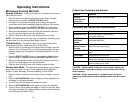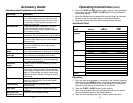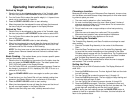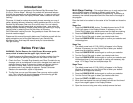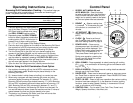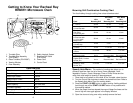
1312
How Your Microwave Oven Works
The microwave oven has an electronic tube called a magnetron that pro-
duces microwaves, very short radio waves. The microwaves then pass
through a wave-guide and into the oven cavity. The microwaves penetrate
the food and cause water molecules within the food to vibrate extremely
rapidly. This vibration causes considerable friction or heat between the
water molecules resulting in a rapid rise in temperature. This type of heat-
ing is very efficient and the cooking time is therefore shorter than in a con-
ventional oven. The rate of heating depends on the moisture content,
shape, volume, and amount of food present. Metallic materials totally
reflect microwaves. Non-metallic materials such as glass, paper, and plas-
tics are partially transparent to microwaves. Microwaves do not directly
heat the oven walls and most cooking utensils because they do not
absorb microwave energy. However, they frequently get very warm through
being in direct contact with hot food.
Testing Containers and Utensils
Some non-metallic containers and utensils become extremely hot when
used in a microwave oven. To avoid risk of scalding, use the following pro-
cedure to determine if a container or utensil is safe for microwave use:
1. Fill a microwave-safe container with 1 cup (250 ml) of cold water. Place
it in the microwave oven along with the container or utensil in question.
2. Turn the oven on maximum power for 1 minute. Do not exceed 1
minute cooking time.
3. Carefully feel the container. If the empty container is warm, do not use
it for microwave cooking.
Hints and Tips
• Stir foods such as casseroles and vegetables while cooking to distrib-
ute heat evenly. Food at the outside of the dish absorbs more energy
and heats more quickly, so stir from the outside to the center.
• Stirring or turning foods during cooking will help to distribute the heat
evenly throughout the food and will prevent overcooking on the edges
of the food. If possible, stir the food before serving.
• Arrange odd shaped foods, such as chicken pieces or chops, with the
thicker, meatier parts toward the outside of the turntable where they
receive more microwave energy. To prevent overcooking, place delicate
areas, such as asparagus tips, towards the center of the turntable.
Arrange frozen food items on a microwave-safe plate like the spokes of
a wheel and leave the center open.
• Turn over large foods, such as roasts, halfway through cooking for even
microwave exposure.
• Foods cooked in the microwave build up internal heat and continue to
cook for a few minutes after heating stops. Let foods stand to com-
plete cooking. For example, roasts need standing time to complete
cooking in the center without overcooking the outer areas. All liquids,
such as soup or hot chocolate, should be stirred when cooking is com-
plete. Let liquids stand a moment before serving.
• Microwave energy is attracted to water molecules. Food that is uneven
in moisture content should be covered or allowed to stand so that the
heat disperses evenly. Add a small amount of water to dry food to help
cook it.
• Cook the food for the shortest time possible. If necessary, add cooking
time until the food reaches the appropriate temperature.
• The quantity, denseness, and temperature of food will determine the
necessary cooking time.
• Check for doneness, and if necessary cook or reheat for additional
time.
• Foods high in fat and sugar cook faster than foods with high water
content.
• Foods similar in size and shape cook more evenly.
• When cooking large pieces of food, reduce the power level to allow for
more even cooking.
• Very moist foods cook more evenly than dryer foods. Foods with a low
moisture content should be covered during cooking. Allow the food to
stand after cooking so that the heat can disperse evenly.
• Covering food while cooking will reduce cooking time, reduce splatter-
ing, and help to keep food moist.
• For best results, use a fork to pierce foods with a skin or membrane
(for example: potatoes, tomatoes, sausages, egg yolks) to prevent
internal steam build-up during cooking.
• The size and shape of a container will also influence the cooking time.
Food prepared in a narrow and shallow casserole will cook more quick-
ly than the same amount of food prepared in a taller container. Since
microwaves penetrate from all sides, round shapes cook more evenly.
• Allow space between foods when arranging on plate before micro-wav-
ing.



